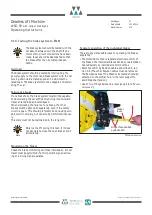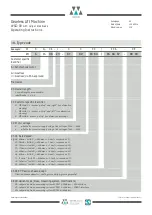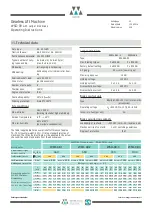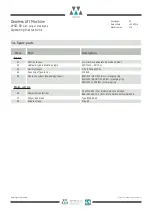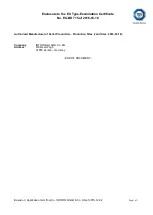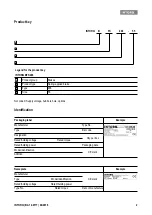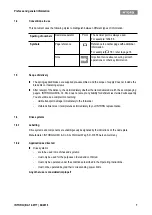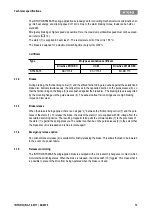
Annex to the EC Type-Examination Certificate
No. EU-BD 715 of 2016-03-18
Note:
The English text is a translation of the German original. In case of any discrepancy, the German version is valid only.
Page 2 of 2
2
Conditions
2.1
Above mentioned safety component represents only a part at the protection device against over-
speed for the car moving in upwards direction and unintended car movement. Only in combination
with a detecting and triggering component in accordance with the standard (two separate compo-
nents also possible), which must be subjected to an own type-examination, can the system created
fulfil the requirements for a protection device.
2.2
The installer of a lift must create an examination instruction to fulfil the overall concept, add it to the
lift documentation and provide any necessary tools or measuring devices, which allow a safe ex-
amination (e. g. with closed shaft doors).
2.3
The single brakes have to be arranged symmetrically around the circumference of the brake disc.
In order to comply with the redundancy required in section 5.6.6.2 of EN 81-20:2014 (D), at least
two braking circuits (single brake actuator) must be used.
2.4
Where more than two braking circuits are used, redundancy requirements necessitate that a suffi-
cient braking effect as outlined in section 5.9.2.2.2.1 of EN 81-20:2014 (D) is still maintained if one
of the braking circuit fails. It is not assumed that two braking circuits will fail simultaneously.
2.5
The manufacturer of the drive unit must provide calculation evidence that the connection traction
sheave
– shaft – brake disc and the shaft itself is sufficiently safe, if the brake disc is not a direct
component of the traction sheave (e. g. casted on). The shaft itself has to be statically supported in
two points.
The calculation evidence must be enclosed with the technical documentation of the lift.
2.6
The setting of the brake force has to be secured against unauthorized adjustment (e. g. sealing
lacquer).
2.7
The identification drawing no. 5019001 including stamp dated 2016-03-18 shall be included to the
EU type-examination for the identification and information of the general construction and operation
and distinctness of the approved type.
2.8
The EU type-examination certificate may only be used in combination with the corresponding an-
nex and enclosure (List of authorized manufacturer of the serial production). The enclosure will be
updated immediately after any change by the certification holder.
3
Remarks
3.1
In the scope of this type-examination it was found out, that the brake device also functions as a
brake for normal operation (using at least two single brakes), is designed as a redundant system
and therefore meets the requirements to be used also as a part of the protection device against
overspeed for the car moving in upwards direction and as braking element as part of the protection
device against unintended car movement.
3.2
Checking whether
the requirements as per section
5.9.2.2 of EN 81-20:2014 (D)
have been
com-
plied
with is not part
of
this type examination.
3.3
Other requirements of the standard, such as reduction of brake moment respectively brake force
due to wear or operational caused changes of traction are
not part
of
this type examination.
3.4
This EU type-examination certificate was issued according to the following standards:
EN 81-1:1998 + A3:2009 (D), Annex F.7 and F.8
EN 81-20:2014 (D), part 5.6.6.11, 5.6.7.13
EN 81-50:2014 (D), part 5.7 and 5.8
3.5
A revision of this EU type-examination certificate is inevitable in case of changes or additions of the
above mentioned standards or of changes of state of the art.
Summary of Contents for Beamer 2 Series
Page 36: ......
Page 37: ......
Page 41: ......



